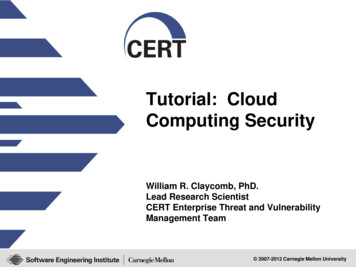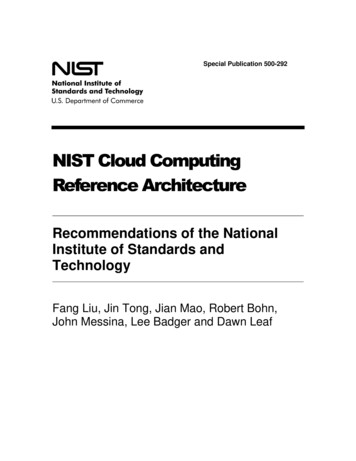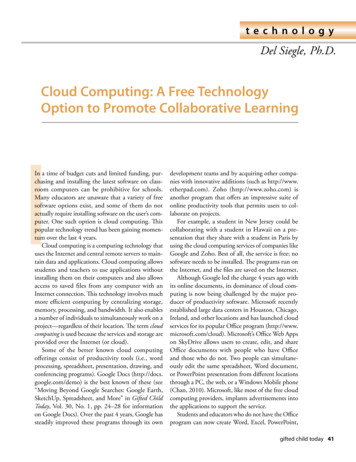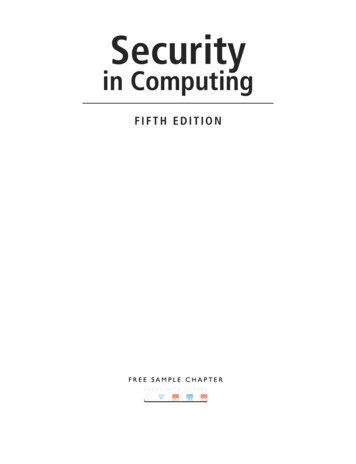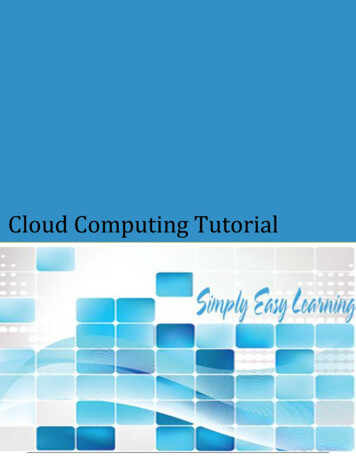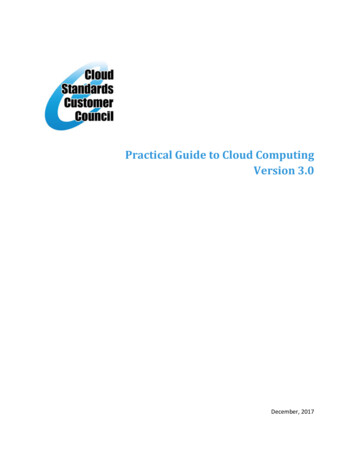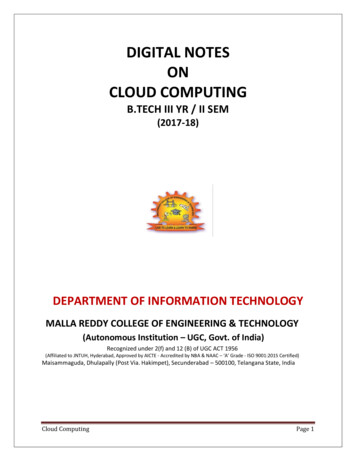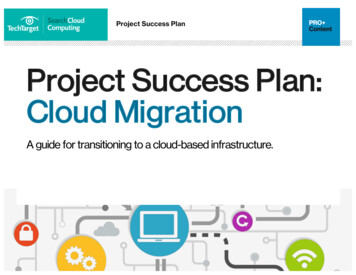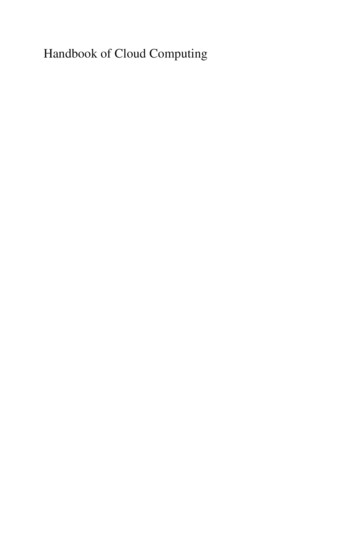
Transcription
Handbook of Cloud Computing
Borko Furht · Armando EscalanteEditorsHandbook of CloudComputing123
EditorsBorko FurhtDepartment of Computer and ElectricalEngineering and Computer ScienceFlorida Atlantic University777 Glades RoadBoca Raton, FL 33431, USAbfurht@fau.eduArmando EscalanteLexisNexis6601 Park of Commerce BoulevardBoca Raton, FL 33487, USAarmando.escalante@lexisnexis.comISBN 978-1-4419-6523-3e-ISBN 978-1-4419-6524-0DOI 10.1007/978-1-4419-6524-0Springer New York Dordrecht Heidelberg LondonLibrary of Congress Control Number: 2010934567 Springer Science Business Media, LLC 2010All rights reserved. This work may not be translated or copied in whole or in part without thewritten permission of the publisher (Springer Science Business Media, LLC, 233 Spring Street,New York, NY 10013, USA), except for brief excerpts in connection with reviews or scholarlyanalysis. Use in connection with any form of information storage and retrieval, electronic adaptation,computer software, or by similar or dissimilar methodology now known or hereafter developed isforbidden.The use in this publication of trade names, trademarks, service marks, and similar terms, even if they arenot identified as such, is not to be taken as an expression of opinion as to whether or not they are subjectto proprietary rights.Printed on acid-free paperSpringer is part of Springer Science Business Media (www.springer.com)
PrefaceCloud computing has become a great solution for providing a flexible, on-demand,and dynamically scalable computing infrastructure for many applications. Cloudcomputing also presents a significant technology trends, and it is already obviousthat it is reshaping information technology processes and the IT marketplace.This Handbook is a carefully edited book – contributors are 65 worldwide expertsin the field of cloud computing and their applications. The Handbook AdvisoryBoard, comprised of nine researchers and practitioners from academia and industry,helped in reshaping the Handbook and selecting the right topics and creative andknowledgeable contributors. The scope of the book includes leading-edge cloudcomputing technologies, systems, and architectures; cloud computing services; anda variety of cloud computing applications.The Handbook comprises four parts, which consist of 26 chapters. The first parton Technologies and Systems includes articles dealing with cloud computing technologies, storage and fault tolerant strategies in cloud computing, workflows, gridcomputing technologies, and the role of networks in cloud computing.The second part on Architectures focuses on articles on several specific architectural concepts applied in cloud computing, including enterprise knowledge clouds,high-performance computing clouds, clouds with vertical load distribution, andpeer-to-peer based clouds.The third part on Services consists of articles on various issues relating to cloudservices, including types of services, service scalability, scientific services, anddynamic collaborative services.The forth part on Applications describes various cloud computing applicationsfrom enterprise knowledge clouds, scientific and statistical computing, scientificdata management, to medical applications.With the dramatic growth of cloud computing technologies, platforms and services, this Handbook can be the definitive resource for persons working in this fieldas researchers, scientists, programmers, engineers, and users. The book is intendedfor a wide variety of people including academicians, designers, developers, educators, engineers, practitioners, researchers, and graduate students. This book canalso be beneficial for business managers, entrepreneurs, and investors. The bookv
viPrefacecan have a great potential to be adopted as a textbook in current and new courses onCloud Computing.The main features of this Handbook can be summarized as:1. The Handbook describes and evaluates the current state-of-the-art in a new fieldof cloud computing.2. It also presents current systems, services, and main players in this explosive field.3. Contributors to the Handbook are the leading researchers from academia andpractitioners from industry.We would like to thank the authors for their contributions. Without their expertiseand effort, this Handbook would never come to fruition. Springer editors and staffalso deserve our sincere recognition for their support throughout the project.Boca Raton, FloridaBorko FurhtArmando Escalante
ContentsPart ITechnologies and Systems1 Cloud Computing Fundamentals . . . . . . . . . . . . . . . . . . .Borko Furht32 Cloud Computing Technologies and Applications . . . . . . . . . .Jinzy Zhu213 Key Enabling Technologies for Virtual Private Clouds . . . . . . .Jeffrey M. Nick, David Cohen, and Burton S. Kaliski Jr.474 The Role of Networks in Cloud Computing . . . . . . . . . . . . .Geng Lin and Mac Devine655 Data-Intensive Technologies for Cloud Computing . . . . . . . . .Anthony M. Middleton836 Survey of Storage and Fault Tolerance Strategies Usedin Cloud Computing . . . . . . . . . . . . . . . . . . . . . . . . . .Kathleen Ericson and Shrideep Pallickara1377 Scheduling Service Oriented Workflows Inside CloudsUsing an Adaptive Agent Based Approach . . . . . . . . . . . . . .Marc Eduard Frîncu1598 The Role of Grid Computing Technologiesin Cloud Computing . . . . . . . . . . . . . . . . . . . . . . . . . .David Villegas, Ivan Rodero, Liana Fong, Norman Bobroff,Yanbin Liu, Manish Parashar, and S. Masoud Sadjadi9 Cloudweaver: Adaptive and Data-Driven WorkloadManager for Generic Clouds . . . . . . . . . . . . . . . . . . . . .Rui Li, Lei Chen, and Wen-Syan Li183219vii
viiiContentsPart II Architectures10Enterprise Knowledge Clouds: Architecture and Technologies . . .Kemal A. Delic and Jeff A. Riley11Integration of High-Performance Computing into CloudComputing Services . . . . . . . . . . . . . . . . . . . . . . . . . .Mladen A. Vouk, Eric Sills, and Patrick Dreher255Vertical Load Distribution for Cloud Computing viaMultiple Implementation Options . . . . . . . . . . . . . . . . . . .Thomas Phan and Wen-Syan Li2771213SwinDeW-C: A Peer-to-Peer Based Cloud Workflow System . . . .Xiao Liu, Dong Yuan, Gaofeng Zhang, Jinjun Chen,and Yun Yang239309Part III Services14Cloud Types and Services . . . . . . . . . . . . . . . . . . . . . . .Hai Jin, Shadi Ibrahim, Tim Bell, Wei Gao, Dachuan Huang,and Song Wu33515Service Scalability Over the Cloud . . . . . . . . . . . . . . . . . .Juan Cáceres, Luis M. Vaquero, Luis Rodero-Merino,Álvaro Polo, and Juan J. Hierro35716Scientific Services on the Cloud . . . . . . . . . . . . . . . . . . . .David Chapman, Karuna P. Joshi, Yelena Yesha, Milt Halem,Yaacov Yesha, and Phuong Nguyen37917A Novel Market-Oriented Dynamic Collaborative CloudService Platform . . . . . . . . . . . . . . . . . . . . . . . . . . . .Mohammad Mehedi Hassan and Eui-Nam Huh407Part IV Applications18Enterprise Knowledge Clouds: Applications and Solutions . . . . .Jeff A. Riley and Kemal A. Delic19Open Science in the Cloud: Towards a Universal Platformfor Scientific and Statistical Computing . . . . . . . . . . . . . . .Karim Chine453Multidimensional Environmental Data Resource Brokeringon Computational Grids and Scientific Clouds . . . . . . . . . . . .Raffaele Montella, Giulio Giunta, and Giuliano Laccetti4752021HPC on Competitive Cloud Resources . . . . . . . . . . . . . . . .Paolo Bientinesi, Roman Iakymchuk, and Jeff Napper437493
Contents222324ixScientific Data Management in the Cloud: A Survey ofTechnologies, Approaches and Challenges . . . . . . . . . . . . . .Sangmi Lee Pallickara, Shrideep Pallickara, and Marlon Pierce517Feasibility Study and Experience on Using CloudInfrastructure and Platform for Scientific Computing . . . . . . .Mikael Fernandus Simalango and Sangyoon Oh535A Cloud Computing Based Patient Centric MedicalInformation System . . . . . . . . . . . . . . . . . . . . . . . . . .Ankur Agarwal, Nathan Henehan, Vivek Somashekarappa,A.S. Pandya, Hari Kalva, and Borko Furht25Cloud@Home: A New Enhanced Computing Paradigm . . . . . .Salvatore Distefano, Vincenzo D. Cunsolo, Antonio Puliafito,and Marco Scarpa26Using Hybrid Grid/Cloud Computing Technologies forEnvironmental Data Elastic Storage, Processing,and Provisioning . . . . . . . . . . . . . . . . . . . . . . . . . . . .Raffaele Montella and Ian FosterIndex . . . . . . . . . . . . . . . . . . . . . . . . . . . . . . . . . . . . .553575595619
ContributorsAnkur Agarwal Department of Computer Science and Engineering, FAU,Boca Raton, FL, USA, ankur@cse.fau.eduTim Bell Department of Computer Science and Software Engineering, Universityof Canterbury, Christchurch, New Zealand, tim.bell@canterbury.ac.nzPaolo Bientinesi AICES, RWTH, Aachen, Germany,pauldj@aices.rwth-aachen.deNorman Bobroff IBM Watson Research Center, Hawthorne, NY, USA,bobroff@us.ibm.comJuan Cáceres Telefónica Investigación y Desarrollo, Madrid, Spain,caceres@tid.esDavid Chapman Computer Science and Electrical Engineering Department,University of Maryland, Baltimore County, MD, USA, dchapm2@umbc.eduJinjun Chen Faculty of Information and Communication Technologies,Swinburne University of Technology, Hawthorn, Melbourne, Australia 3122,jchen@swin.edu.auLei Chen Hong Kong University of Science and Technology, Clear Water Bay,Hong Kong, leichen@cse.ust.hkKarim Chine Cloud Era Ltd, Cambridge, UK, karim.chine@polytechnique.orgDavid Cohen Cloud Infrastructure Group, EMC Corporation, Cambridge, MA,USA, david.cohen@emc.comVincenzo D. Cunsolo University of Messina, Contrada di Dio, S. Agata, Messina,Italy, vdcunsolo@unime.itKemal A. Delic Hewlett-Packard Co., New York, NY, USA, kemal.delic@hp.comMac Devine IBM Corporation, Research Triangle Park, NC, USA,wdevine@us.ibm.comxi
xiiContributorsSalvatore Distefano University of Messina, Contrada di Dio, S. Agata, Messina,Italy, sdistefano@unime.itPatrick Dreher Renaissance Computing Institute, Chapel Hill, NC, 27517 USA,dreher@renci.orgKathleen Ericson Department of Computer Science, Colorado State University,Fort Collins, CO, USA, ericson@cs.colostate.eduLiana Fong IBM Watson Research Center, Hawthorne, NY, USA,llfong@us.ibm.comIan Foster Argonne National Laboratory, Argonne, IL, USA; The Universityof Chicago, Chicago, IL, USA, foster@anl.govMarc Eduard Frîncu Institute e-Austria, Blvd. Vasile Parvan No 4 300223,Room 045B, Timisoara, Romania, mfrincu@info.uvt.roBorko Furht Department of Computer & Electrical Engineering and ComputerScience, Florida Atlantic University, Boca Raton, FL, USA, bfurht@fau.eduWei Gao Services Computing Technology and System Lab; Cluster and GridComputing Lab, Huazhong University of Science and Technology, Wuhan, China,gaowei715@gmail.comGiulio Giunta Department of Applied Science, University of Napoli Parthenope,Napoli, Italy, giulio.giunta@uniparthenope.itMilt Halem Computer Science and Electrical Engineering Department, Universityof Maryland, Baltimore County, MD, USA, halem@umbc.eduMohammad Mehedi Hassan Department of Computer Engineering, Kyung HeeUniversity, Global Campus, South Korea, hassan@khu.ac.krNathan Henehan Senior Software Developer, NACS Solutions, Oberlin, OH,USA, nhenehan@gmail.comJuan J. Hierro Telefónica Investigación y Desarrollo, Madrid, Spain,jhierro@tid.esDachuan Huang Services Computing Technology and System Lab; Cluster andGrid Computing Lab, Huazhong University of Science and Technology, Wuhan,China, hdc1112@gmail.comEui-Nam Huh Department of Computer Engineering, Kyung Hee University,Global Campus, South Korea, johnhuh@khu.ac.krRoman Iakymchuk AICES, RWTH, Aachen, Germany,iakymchuk@aices.rwth-aachen.deShadi Ibrahim Services Computing Technology and System Lab; Cluster andGrid Computing Lab, Huazhong University of Science and Technology, Wuhan,China, shadi@hust.edu.cn
ContributorsxiiiHai Jin Services Computing Technology and System Lab; Cluster and GridComputing Lab, Huazhong University of Science and Technology, Wuhan, China,hjin@hust.edu.cnKaruna P. Joshi Computer Science and Electrical Engineering Department,University of Maryland, Baltimore County, MD, USA, kjoshi1@umbc.eduBurton S. Kaliski Jr. Office of the CTO, EMC Corporation, Hopkinton, MA,USA, burt.kaliski@emc.comHari Kalva Department of Computer Science and Engineering, FAU,Boca Raton, FL, USA, hari.kalva@fau.eduGiuliano Laccetti Department of Mathematics and Applications, Universityof Napoli Federico II, Napoli, Italy, giuliano.laccetti@unina.itRui Li Hong Kong University of Science and Technology, Clear Water Bay,Hong Kong, cslr@cse.ust.hkWen-Syan Li SAP Technology Lab, Shanghai, China, wen-syan.li@sap.comGeng Lin IBM Alliance, Cisco Systems, San Francisco, CA, USA,gelin@cisco.comXiao Liu Faculty of Information and Communication Technologies, SwinburneUniversity of Technology, Hawthorn, Melbourne, Australia 3122,xliu@groupwise.swin.edu.auYanbin Liu IBM Watson Research Center, Hawthorne, NY, USA,ygliu@us.ibm.comAnthony M. Middleton LexisNexis Risk Solutions, Boca Raton, FL, USA,tony.middleton@lexisnexis.comRaffaele Montella Department of Applied Science, University of NapoliParthenope, Napoli, Italy, raffaele.montella@uniparthenope.itJeff Napper Vrije Universiteit, Amsterdam, Netherlands, jnapper@cs.vu.nlPhuong Nguyen Computer Science and Electrical Engineering Department,University of Maryland, Baltimore County, MD, USA, phuong3@umbc.eduJeffrey M. Nick Office of the CTO, EMC Corporation, Hopkinton, MA, USA,jeff.nick@emc.comSangyoon Oh WISE Research Lab, School of Information and CommunicationEngineering, Ajou University, Suwon, South Korea, syoh@ajou.ac.krShrideep Pallickara Department of Computer Science, Colorado State University,Fort Collins, CO, USA, shrideep@cs.colostate.eduSangmi Lee Pallickara Department of Computer Science, Colorado StateUniversity, Fort Collins, CO, USA, sangmi@cs.colostate.edu
xivContributorsA.S. Pandya Department of Computer Science and Engineering, FAU,Boca Raton, FL, USA, pandya@fau.eduManish Parashar NSF CAC, Rutgers University, Piscataway, NJ, USA,parashar@rutgers.eduThomas Phan Microsoft Corporation, Washington, DC, USA,thomas.phan@acm.orgMarlon Pierce Community Grids Lab, Indiana University, Bloomington, IN,USA, mpierce@cs.indiana.eduÁlvaro Polo Telefónica Investigación y Desarrollo, Madrid, Spain, apv@tid.esAntonio Puliafito University of Messina, Contrada di Dio, S. Agata, Messina,Italy, apuliafito@unime.itJeff A. Riley Hewlett-Packard Co., New York, NY, USA, jeff.riley@hp.comIvan Rodero NSF CAC, Rutgers University, Piscataway, NJ, USA,irodero@rutgers.eduLuis Rodero-Merino INRIA-ENS, INRIA, Lyon, France,luis.rodero-merino@ens-lyon.frS. Masoud Sadjadi CIS, Florida International University, Miami, FL, USA,sadjadi@cis.fiu.eduMarco Scarpa University of Messina, Contrada di Dio, S. Agata, Messina, Italy,mscarpa@unime.itEric Sills North Carolina State University, Raleigh, NC 27695, USA,edsills@ncsu.eduMikael Fernandus Simalango WISE Research Lab, Ajou University, Suwon,South Korea, mikael@ajou.ac.krVivek Somashekarappa Armellini Inc., Palm City, FL, USA,vsomashekar@gmail.comLuis M. Vaquero Telefónica Investigación y Desarrollo, Madrid, Spain,lmvg@tid.esDavid Villegas CIS, Florida International University, Miami, FL, USA,dvill013@cis.fiu.eduMladen A. Vouk Department of Computer Science, North Carolina StateUniversity, Box 8206, Raleigh, NC 27695, USA, vouk@ncsu.eduSong Wu Services Computing Technology and System Lab; Cluster and GridComputing Lab, Huazhong University of Science and Technology, Wuhan, China,wusong@mail.hust.edu.cn
ContributorsxvYun Yang Faculty of Information and Communication Technologies, SwinburneUniversity of Technology, Hawthorn, Melbourne, Australia 3122,yyang@groupwise.swin.edu.auYelena Yesha Computer Science and Electrical Engineering Department,University of Maryland, Baltimore County, MD, USA, yeyesha@csee.umbc.eduYaacov Yesha Computer Science and Electrical Engineering Department,University of Maryland, Baltimore County, MD, USA, yayesha@umbc.eduDong Yuan Faculty of Information and Communication Technologies, SwinburneUniversity of Technology, Hawthorn, Melbourne, Australia 3122,dyuan@groupwise.swin.edu.auGaofeng Zhang Faculty of Information and Communication Technologies,Swinburne University of Technology, Hawthorn, Melbourne, Australia 3122,gzhang@groupwise.swin.edu.auJinzy Zhu IBM Cloud Computing Center, China, jinzyzhu@cn.ibm.com
About the EditorsBorko Furht is a professor and chairman of the Department of Electrical &Computer Engineering and Computer Science at Florida Atlantic University (FAU)in Boca Raton, Florida. He is also Director of recently formed NSF-sponsoredxvii
xviiiAbout the EditorsIndustry/University Cooperative Research Center on Advanced KnowledgeEnablement. Before joining FAU, he was a vice president of research and a seniordirector of development at Modcomp (Ft. Lauderdale), a computer company ofDaimler Benz, Germany; a professor at University of Miami in Coral Gables,Florida; and a senior researcher in the Institute Boris Kidric-Vinca, Yugoslavia.Professor Furht received a Ph.D. degree in electrical and computer engineeringfrom the University of Belgrade. His current research is in multimedia systems,video coding and compression, 3D video and image systems, wireless multimedia,and Internet and cloud computing. He is presently Principal Investigator and Co-PIof several multiyear, multimillion-dollar projects, including NSF PIRE project andNSF High-Performance Computing Center. He is the author of numerous booksand articles in the areas of multimedia, computer architecture, real-time computing,and operating systems. He is a founder and editor-in-chief of the Journal ofMultimedia Tools and Applications (Springer). He has received several technicaland publishing awards, and has consulted for many high-tech companies includingIBM, Hewlett-Packard, Xerox, General Electric, JPL, NASA, Honeywell, andRCA. He has also served as a consultant to various colleges and universities. Hehas given many invited talks, keynote lectures, seminars, and tutorials. He servedon the Board of Directors of several high-tech companies.Armando J. Escalante is Senior Vice President and Chief Technology Officerof Risk Solutions for the LexisNexis Group, a division of Reed Elsevier. In thisposition, Escalante is responsible for technology development, information systemsand operations. Previously, Escalante was Chief Operating Officer for Seisint, a
About the Editorsxixprivately owned company, which was purchased by LexisNexis in 2004. In thisposition, he was responsible for Technology, Development and Operations. Prior to2001, Escalante served as Vice President of Engineering and Operations for DiveoBroadband Networks, where he led world-class Data Centers located in the U.S.and Latin America. Before Diveo Broadband Networks, Escalante was VP for oneof the fastest growing divisions of Vignette Corporation, an eBusiness softwareleader. Escalante earned his bachelor’s degree in electronic engineering at the USBin Caracas, Venezuela and a master’s degree in computer science from StevensInstitute of Technology, as well as a master’s degree in business administrationfrom West Coast University.
Part ITechnologies and Systems
Chapter 1Cloud Computing FundamentalsBorko Furht1.1 IntroductionIn the introductory chapter we define the concept of cloud computing and cloudservices, and we introduce layers and types of cloud computing. We discuss thedifferences between cloud computing and cloud services. New technologies thatenabled cloud computing are presented next. We also discuss cloud computingfeatures, standards, and security issues. We introduce the key cloud computing platforms, their vendors, and their offerings. We discuss cloud computing challengesand the future of cloud computing.Cloud computing can be defined as a new style of computing in which dynamically scalable and often virtualized resources are provided as a services over theInternet. Cloud computing has become a significant technology trend, and manyexperts expect that cloud computing will reshape information technology (IT) processes and the IT marketplace. With the cloud computing technology, users usea variety of devices, including PCs, laptops, smartphones, and PDAs to accessprograms, storage, and application-development platforms over the Internet, via services offered by cloud computing providers. Advantages of the cloud computingtechnology include cost savings, high availability, and easy scalability.Figure 1.1, adapted from Voas and Zhang (2009), shows six phases of computingparadigms, from dummy terminals/mainframes, to PCs, networking computing, togrid and cloud computing.In phase 1, many users shared powerful mainframes using dummy terminals.In phase 2, stand-alone PCs became powerful enough to meet the majority ofusers’ needs. In phase 3, PCs, laptops, and servers were connected together throughlocal networks to share resources and increase performance. In phase 4, local networks were connected to other local networks forming a global network such asthe Internet to utilize remote applications and resources. In phase 5, grid computing provided shared computing power and storage through a distributed computingB. Furht (B)Department of Computer & Electrical Engineering and Computer Science, Florida AtlanticUniversity, Boca Raton, FL, USAe-mail: bfurht@fau.eduB. Furht, A. Escalante (eds.), Handbook of Cloud Computing,C Springer Science Business Media, LLC 2010DOI 10.1007/978-1-4419-6524-0 1, 3
4B. FurhtPhases1. MainframeComputingUserTerminalMainframe2. PCComputingUserPCPCServer3. NetworkComputingUserPCServerServer4. InternetComputingInternetUserPCUserPC5. GridComputingServerGridCloud6. CloudComputingUserPCFig. 1.1 Six computing paradigms – from mainframe computing to Internet computing, to gridcomputing and cloud computing (adapted from Voas and Zhang (2009))system. In phase 6, cloud computing further provides shared resources on theInternet in a scalable and simple way.Comparing these six computing paradigms, it looks like that cloud computingis a return to the original mainframe computing paradigm. However, these twoparadigms have several important differences. Mainframe computing offers finitecomputing power, while cloud computing provides almost infinite power and capacity. In addition, in mainframe computing dummy terminals acted as user interfacedevices, while in cloud computing powerful PCs can provide local computing powerand cashing support.1.1.1 Layers of Cloud ComputingCloud computing can be viewed as a collection of services, which can be presentedas a layered cloud computing architecture, as shown in Fig. 1.2 [Jones XXXX]. The
1Cloud Computing FundamentalsFig. 1.2 Layered architectureof Cloud Computing (adaptedfrom aSVirtualizationServers and StoragedSaaSservices offered through cloud computing usually include IT services referred as toSaaS (Software-as-a-Service), which is shown on top of the stack. SaaS allows usersto run applications remotely from the cloud.Infrastructure-as-a-service (IaaS) refers to computing resources as a service.This includes virtualized computers with guaranteed processing power and reservedbandwidth for storage and Internet access.Platform-as-a-Service (PaaS) is similar to IaaS, but also includes operating systems and required services for a particular application. In other words, PaaS is IaaSwith a custom software stack for the given application.The data-Storage-as-a-Service (dSaaS) provides storage that the consumer isused including bandwidth requirements for the storage.An example of Platform-as-aService (PaaS) cloud computing is shown in Fig. 1.3[“Platform as a Service,” http://www.zoho.com/creator/paas.html]. The PaaS provides Integrated Development Environment (IDE) including data security, backupand recovery, application hosting, and scalable architecture.According to Chappell (2008) there are three categories of cloud services, asillustrated in Fig. 1.4. Figure 1.4a shows the cloud service SaaS, where the entireapplication is running in the cloud. The client contains a simple browser to accessthe application. A well-known example of SaaS is salesforce.com.Figure 1.4b illustrates another type of cloud services, where the application runson the client; however it accesses useful functions and services provided in thecloud. An example of this type of cloud services on the desktop is Apple’s iTunes.
6B. d Development ApplicationHostingScalableInfrastructureCloudFig. 1.3 The concept of Platform-as-a-Service, Zoho Creator (adapted from “Platform as aService,” http://www.zoho.com/creator/paas.html)a) Software as a Serviceb) Attached pplicationApplicationUsersUsersDevelopersFig. 1.4 The categories of cloud services (adopted from Chappell (2008))The desktop application plays music, while the cloud service is used to purchasea new audio and video content. An enterprise example of this cloud service isMicrosoft Exchange Hosted Services. On-premises Exchange Server is using addedservices from the cloud including spam filtering, archiving, and other functions.
1Cloud Computing Fundamentals7Finally, Fig. 1.4c shows a cloud platform for creating applications, which is usedby developers. The application developers create a new SaaS application using thecloud platform.1.1.2 Types of Cloud ComputingThere are three types of cloud computing (“Cloud Computing,” Wikipedia,http://en.wikipedia.org/wiki/Cloud computing): (a) public cloud, (b) private cloud,and (c) hybrid cloud, as illustrated in Fig. 1.5.Fig. 1.5 Three types of nalPrivateInternalPublicUserUserUserIn the public cloud (or external cloud) computing resources are dynamically provisioned over the Internet via Web applications or Web services from an off-sitethird-party provider. Public clouds are run by third parties, and applications fromdifferent customers are likely to be mixed together on the cloud’s servers, storagesystems, and networks.Private cloud (or internal cloud) refers to cloud computing on private networks.Private clouds are built for the exclusive use of one client, providing full controlover data, security, and quality of service. Private clouds can be built and managedby a company’s own IT organization or by a cloud provider.A hybrid cloud environment combines multiple public and private cloud models. Hybrid clouds introduce the complexity of determining how to distributeapplications across both a public and private cloud.
8B. Furht1.1.3 Cloud Computing Versus Cloud ServicesIn this section we present two tables that show the differences and major attributesof cloud computing versus cloud services (Jens, 2008). Cloud computing is theIT foundation for cloud services and it consists of technologies that enable cloudservices. The key attributes of cloud computing are shown in Table 1.1.In Key attributes of cloud services are summarized in Table 1.2 (Jens, 2008).Table 1.1 Key Cloud Computing Attributes (adapted from Jens (2008))AttributesDescriptionInfrastructure systemsIt includes servers, storage, and networks that can scale asper user demand.It provides Web-based user interface, Web services APIs,and a rich variety of configurations.It supports the development and integration of cloudapplication software.It supports rapid self-service provisioning and configurationand usage monitoring.They connect end users to the cloud and the infrastructurecomponents.Application softwareApplication development anddeployment softwareSystem and applicationmanagement softwareIP networksTable 1.2 Key Attributes of Cloud Services (adapted from Jens (2008))AttributesDescriptionOffsite. Third-party providerIn the cloud execution, it is assumed that third-partyprovides services. There is also a possibility of in-housecloud service delivery.Services are accessed via standard-based, universal networkaccess. It can also include security and quality-of-serviceoptions.There is a simplified specification of requirements.It includes self-service requesting, near real-timedeployment, and dynamic and fine-grained scaling.Pricing is based on usage-based capability and it isfine-grained.User interface include browsers for a variety of devices andwith rich capabilities.System interfaces are based on Web services APIsproviding a standard framework for accessing andintegrating among cloud services.Resources are shared among cloud services users; howevervia configuration options with the service, there is theability to customize.Accessed via the InternetMinimal or no IT skill requiredProvisioningPricingUser interfaceSystem interfaceShared resources
1Cloud Computing Fundamentals91.2 Enabling TechnologiesKey technologies that enabled cloud computing are described in this section; theyinclude virtualization, Web service and service-oriented architecture, service flowsand workflows, and Web 2.0 and mashup.1.2.1 VirtualizationThe advantage of cloud computing is the ability to virtualize and share resourcesamong different applications with the objective for better server utilization.Figure 1.6 shows an example Jones]. In non-cloud computing three independentplatforms exist for three different applications running on its own server. In thecloud, servers can be shared, or virtualized, for operating systems and applicationsresulting in fewer servers (in specific example two servers).Fig. 1.6 An example ofvirtualization: in non-cloudcomputing there is a need forthree servers; in the cloudcomputing, two servers areused (adapted from Jones)ApplicationOS 2ApplicationApplicationServer YOS 1OS 3Server ZServer XApplication ApplicationApplicationOS 1OS 2OS 3HypervisorServer BServer ACloudVirtualization tech
The scope of the book includes leading-edge cloud computing technologies, systems, and architectures; cloud computing services; and a variety of cloud computing applications. The Handbook comprises four parts, which consist of 26 chapters. The first part on Technologies and Sys

